
Italians are very proud of their culinary heritage, and rightly so. There are even some traditional Italian dishes for which an official recipe has been established. This helps to preserve the traditional dishes in their original form. The most famous of those is Ragù alla Bolognese, the famous pasta sauce from the city of Bologna. The official recipe was originally deposited at the chamber of commerce of Bologna on October 17, 1982 (I blogged about that here). But on April 20, 2023, a new official recipe for the ‘real’ Ragù alla Bolognese has been deposited at that same chamber of commerce. This new recipe replaces the one from 1982.
Click here if you just want the recipe, or keep reading if you are interested in my commentary of the differences between the old and the new official recipes.
The ‘renewed’ recipe has been researched by a special committee of the Accademia Italiana della Cucina (Italian Culinary Academy). The reason cited for updating the recipe after more than 40 years, is that due to developments in ingredients, cooking habits, and cooking equipment, the way that Ragù alla Bolognese is prepared has evolved. It sounds a bit counterintuitive to modernize a traditional recipe, but that is basically what they have done.
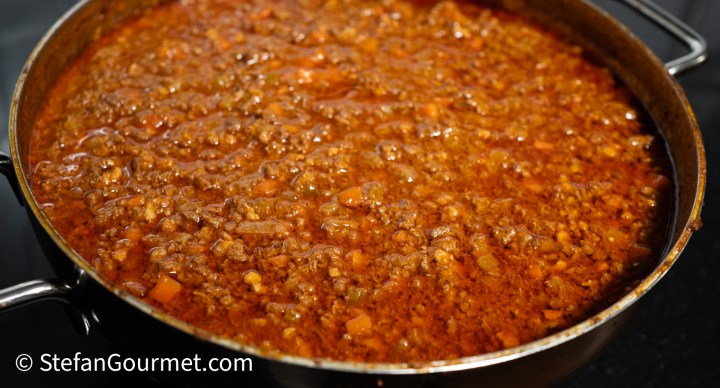
What I really like about the new recipe, is that they have stipulated which variations are acceptable, and which are not. There are many recipes for “Bolognese” out there (especially outside of Italy) that are not authentic. They can still be delicious, they can still be called ragù, and they can even still be Italian, but they should not be called “Bolognese”! Because Ragù alla Bolognese means “ragù as it is made in Bologna”, and so you should not call something Bolognese if it is not like it is made in Bologna.
In this article I will compare the official recipes from 1982 and 2023. At the end I will also mention the variations that are allowed and not allowed in the 2023 recipe. I have prepared a batch of the 2023 recipe, and it turned out great. It doesn’t taste very different from the 1982 recipe, which makes sense, as it would be strange to really alter a traditional dish. The most noticeable difference was a bit less tomato flavor, as can be expected as the ratio of meat to tomato has changed.
Ingredients
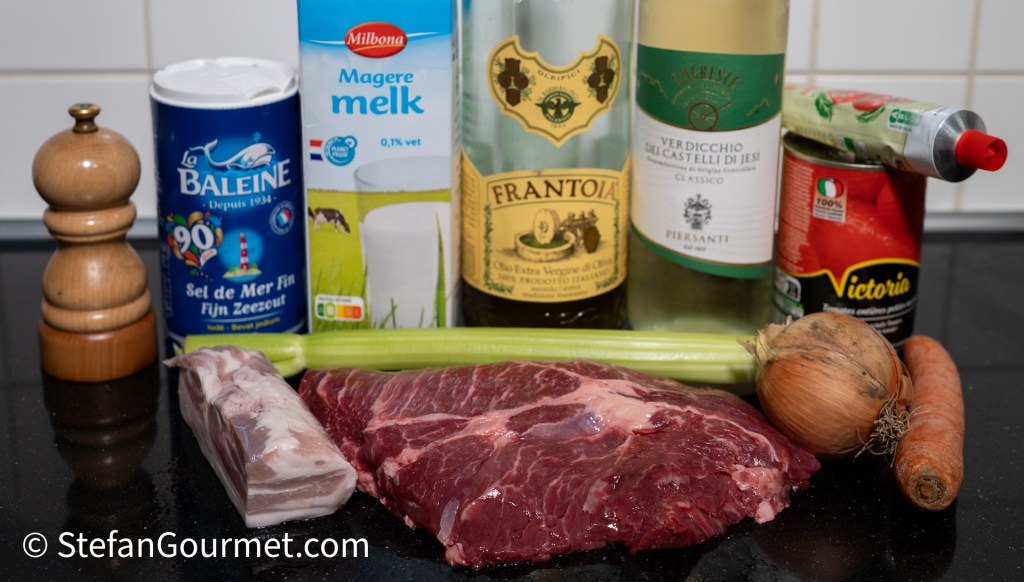
For 4 servings (to serve with about 400 grams of pasta)
- Ground beef
- 1982: 300 grams of coarsely ground beef (skirt or plate or shoulder)
- 2023: 400 grams of coarsely ground beef. Traditionally in Bologna they used a cut called cartella, which is plate or skirt. If you can’t find it, or to mix, it is preferred to use tough cuts from the front or shoulder like brisket, blade steak, or chuck. It is allowed to mix different cuts. It is also allowed to use a mixture of beef (60%) and pork (40%, shoulder). It is allowed to chop the meat by knife rather than grinding it.
- Comments: It is interesting to note that the amount of meat has increased, and that substituting part of the beef with pork is now also allowed.
- Pancetta
- 1982: 150 grams of pancetta
- 2023: 150 grams of fresh pork belly, sliced; may be substituted with cured pancetta, flat or rolled up .
- Comments: It is interesting that the cured pancetta of 1982 is now substituted by fresh pork belly, although cured pancetta is still allowed. I personally prefer to use cured pancetta, as it adds more depth of flavor. But for this batch I have used fresh pork belly.
- Aromatics
- 1982: 50 grams of onion, 50 grams of carrot, 50 grams of celery
- 2023: 1/2 onion, about 60 grams, 1 carrot, about 60 grams, 1 stick celery, about 60 grams
- Comments: no real changes here. The new amount seems slightly higher, but with the higher amount of ground beef, the ratio is about the same.
- Wine
- 1982: 1/2 glass of red/white wine
- 2023: 1 glass of red or white wine
- Comments: I have not been able to find the recipe from 1982 on the website of the Accademia or the Chamber of Commerce, and in the copies I found online both the amount and color of wine for the 1982 recipe is not consistent. So I am not sure if anything has changed here. Note that in Italy 1 glass in a recipe usually means about 100 ml.
- Tomatoes
- 1982: 300 grams of sieved tomatoes or peeled tomatoes; or 5 Tbsp tomato sauce; or 20 grams triple-concentrated tomato paste
- 2023: 200 grams of sieved tomatoes + 1 Tbsp of double-concentrated tomato paste
- Comments: Ragù alla Bolognese should always be a beef sauce with tomato, rather than a tomato sauce with beef. This has become even more true in the 2023 recipe, as the amount of tomato in relation to the beef has been decreased quite a bit. In 1982 the ratio was 300 grams of tomatoes for 300 grams of beef, in 2023 the ratio is roughly 250 grams (200 grams sieved + 1 tablespoon triple concentrate) for 400 grams of beef. However, this difference is not apparent when the other options for tomato from the 1982 recipe are used (5 tablespoons of “tomato sauce” or 20 grams of triple-concentrate).
- Milk
- 1982: 1 glass of whole (full fat) milk + optionally 1/2 glass of cream
- 2023: 1 glass of whole (full fat) milk, optional
- Comments: It is interesting to note that milk has gone from a fixed ingredient to an optional one. The 1982 recipe also mentions that if dried rather than fresh pasta is used, some cream may be added at the end. Note that in Italy 1 glass in a recipe usually means about 100 ml.
- Stock
- 1982: stock
- 2023: water, beef stock, or vegetable stock (also from a bouillon cube)
- Comments: in 1982 only stock is mentioned without specifying it; in 2023 it is specified that it may be beef or vegetable, but water may be used as well. I find it appalling that stock from a bouillon cube is allowed as well; this is probably because its use has become common. Bouillon cubes in Italy are much higher quality than here in the Netherlands though. In Italy they typically contain 10% beef concentrate, but in the Netherlands only about 1%.
- Fat
- 1982: 3 Tbsp olive oil or 50 grams butter
- 2023: 3 Tbsp of extra virgin olive oil
- Comments: Bologna is on the border between Emilia (butter) and Romagna (olive oil), and so it makes sense that in the 1982 recipe both options were allowed. But apparently it is more modern to use olive oil, so the 2023 recipe does not mention butter anymore. In the description of allowed and forbidden variations, nothing is mentioned about butter.
- Salt and pepper (no difference here between 1982 and 2023)
Preparation

When using fresh pork belly, grind or mince it. The 1982 recipe used cured pancetta and said to first dice the pancetta and then mince it finely with a mezzaluna (a round knife with two handles that is very handy for mincing).
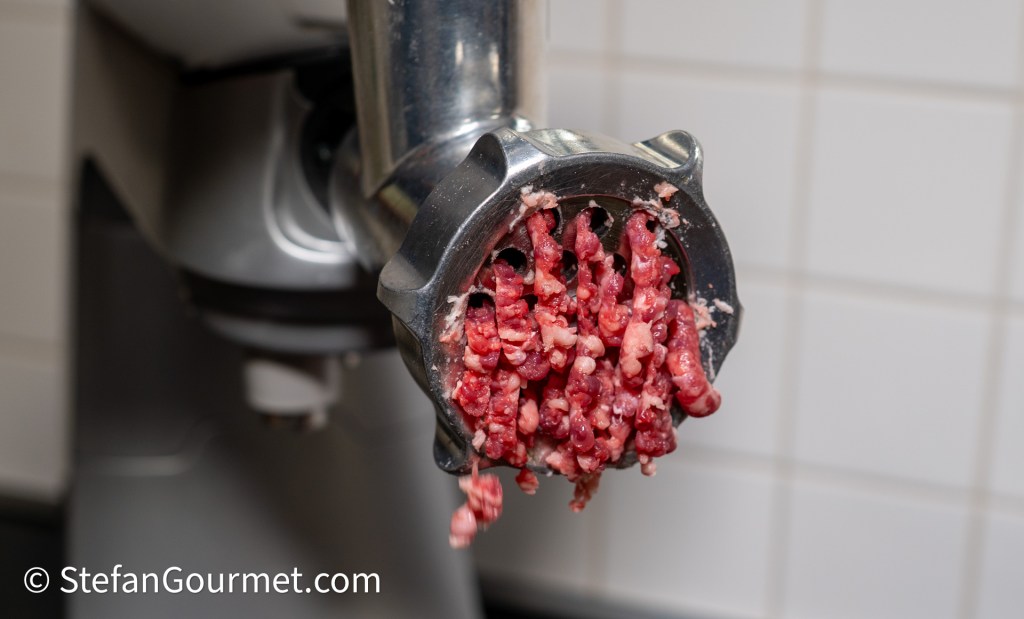
Grind the beef as well, coarsely. Store-bought ground beef is often ground finely and you do not know what cuts were used. This is why I prefer to grind my own. I used chuck in this case.
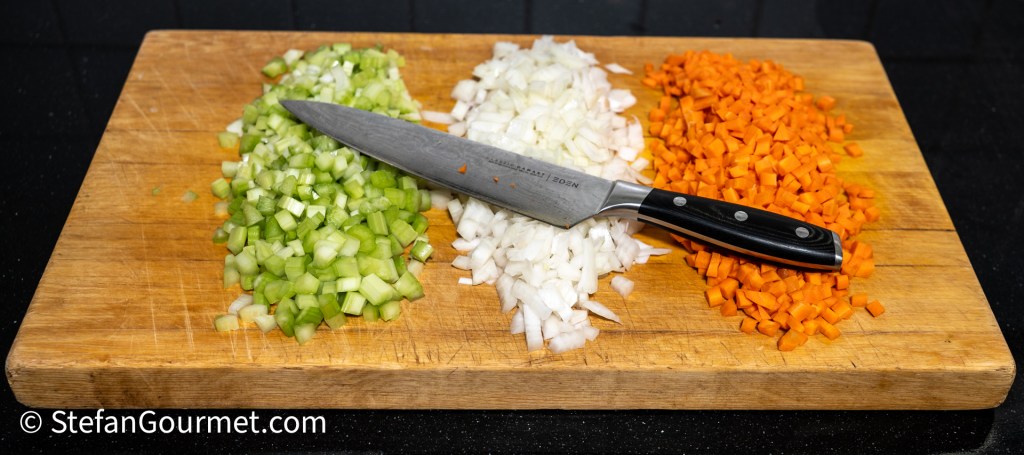
Both the 1982 and 2023 recipes state that the aromatics should be finely minced, but the 2023 recipe stipulates that this should be done on a cutting board and not using a food processor. I think the reason for this is that the aromatics can be browned better when they have been cut by hand (with a sharp knife) compared to a food processor, which will also crushes the vegetables. This means they will release more water, and it will be more difficult to get a good browning. I don’t think it’s a big deal if If you want to use a food processor anyway.
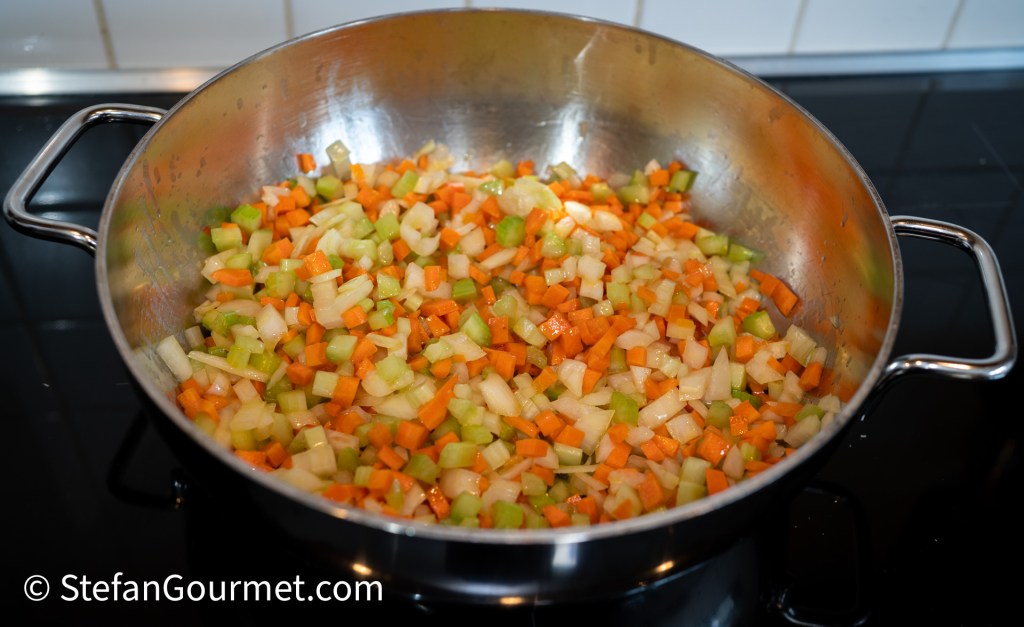
About the cooking vessel:
- 1982: a low casserole (tegame), possibly of terracotta or thick aluminum, of about 20 cm (8 inches)
- 2023: a heavy casserole of high quality, non-stick or aluminum or enameled cast iron (once upon a time a low earthenware casserole was used a lot) with a diameter of 24-26 cm (10 inches)
- Comments: it is interesting that the width of the casserole has increased, which allows for better browning in the initial part of the recipe. It is also interesting that non-stick is mentioned. I would venture that this is more because non-stick pans are now used a lot in Italian households and has therefore become acceptable, but not because it will yield a better result. Terracotta or earthenware casseroles won’t work on induction, which is probably why that is not prescribed anymore. Apart from a sufficient size, the main point of the cooking vessel is that it should have good heat distribution, which is indicated by “thick” in 1982 and by “heavy” in 2023.
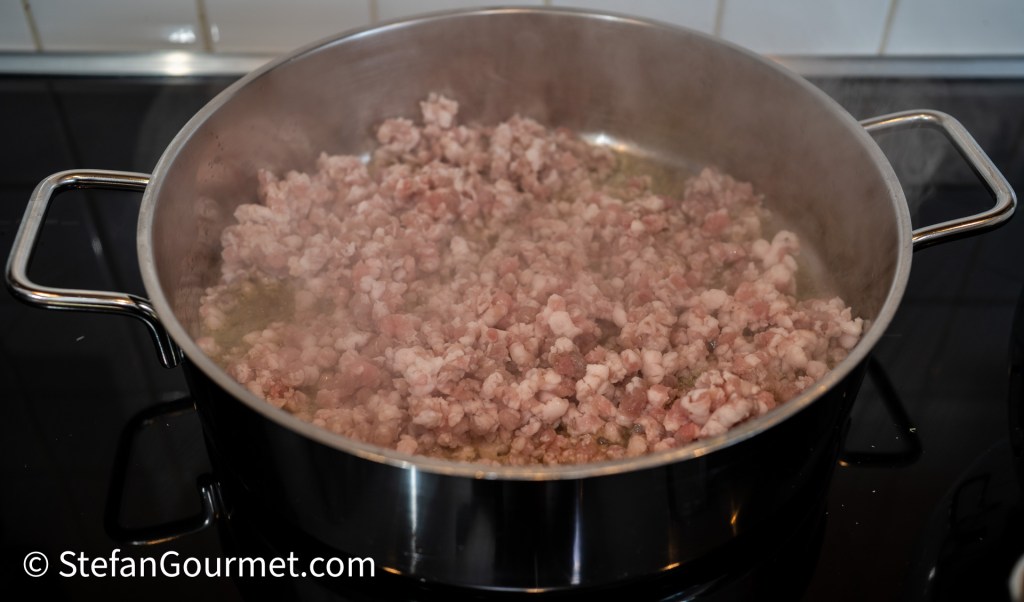
About sautéing the aromatics, pork belly / pancetta, and ground beef:
- 1982: let the pancetta melt, then add 3 tablespoons of oil or 50 grams of butter and the minced aromatics, and sauté gently. Add the ground meat and stir well with a large spoon until the meat sizzles.
- 2023: melt the pancetta with 3 tablespoos of oil. Then, add the finely minced aromatics, and let it sauté gently over medium-low heat, stirring continuously with a large wooden spoon. The onion should absolutely not get a burnt taste. Increase the heat, add the ground meat, and while still stirring accurately, cook for about 10 minutes until the meat sizzles. Note: according to a modern technique, the meat and aromatics are browned separately and added together afterwards.
- Comments: the main difference is the alternate ‘modern’ technique that is proposed in the 2023 recipe, which allows one to brown everything more accurately and thus develop more Maillard flavors. I did apply this method, although I browned the pork and beef together. With regards to browning the meat, I would not recommend to adhere strictly to the 10 minutes, but instead just sauté as long or as short as needed to get the right level of browning. This is because that time will depend on the size of your pan, the amount you are making (I usually prepare a quadruple recipe when I make this), the heat, etc.
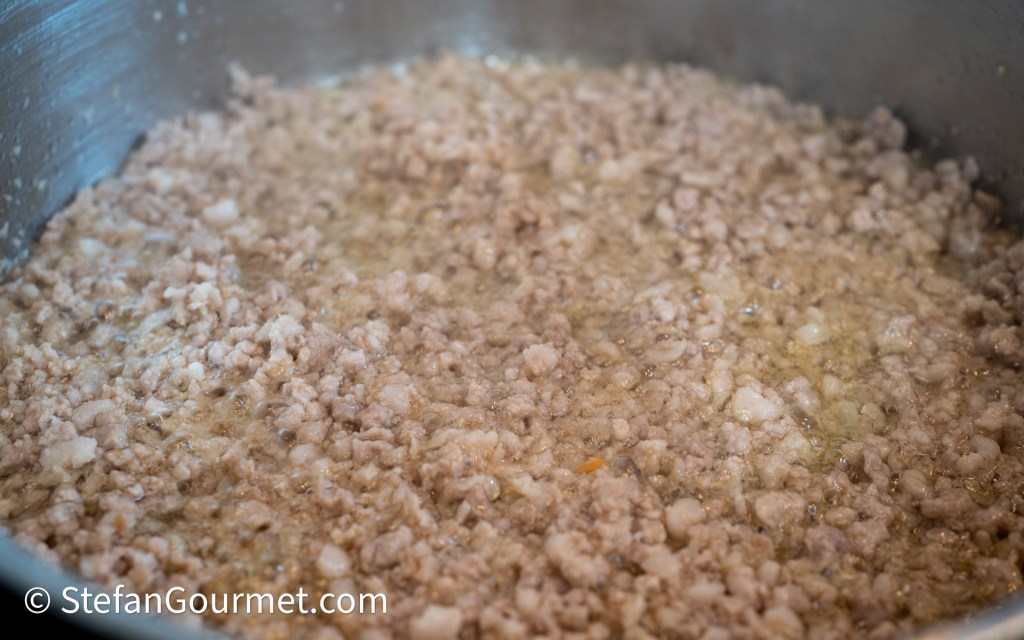
What I did was to first let the ground pork belly melt in 1 tablespoon of oil…
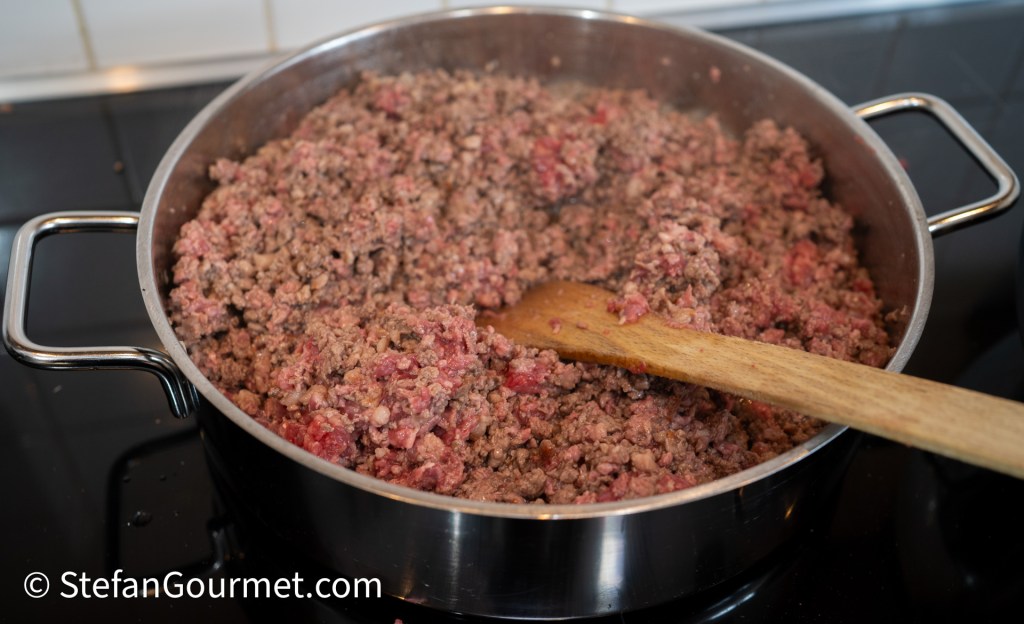
…then I added the ground beef, and stirred over higher heat with a wooden spatula…

…until it sizzled. The sizzling means that most of the water has evaporated. The liquid you can still see is the fat that has been rendered from the meat and the olive oil.

To save time I sautéed the aromatics and meat in parallel using two different pans and stirred them in turns. This is cheating a little, because you are supposed to stir both of them constantly to get the best browning. I used the remaining two tablespoons of olive oil to sauté the aromatics.
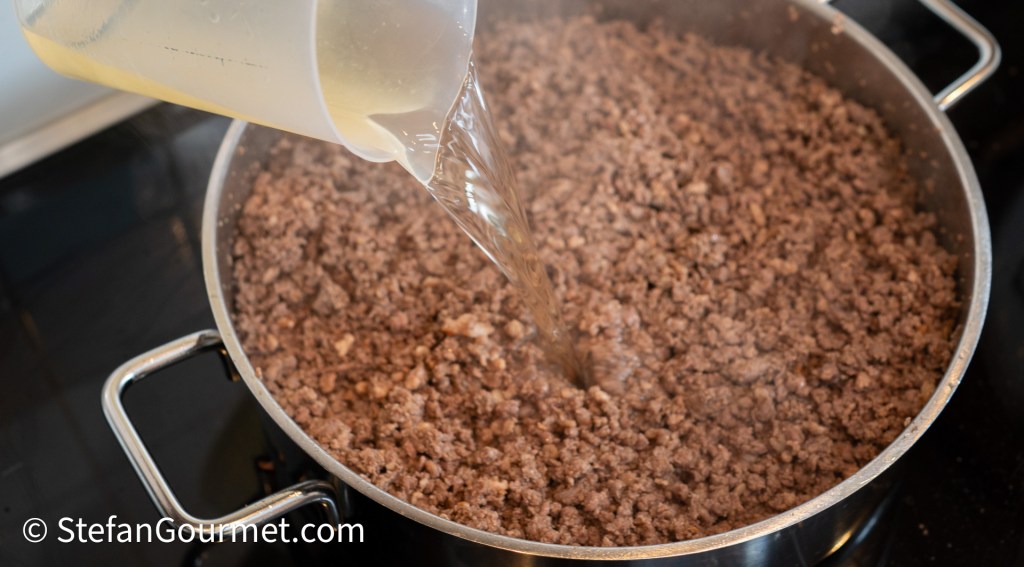
Adding the wine:
- 1982: Deglaze with the wine and stir gently until it has evaporated completely.
- 2023: Add the wine and allow it to evaporate and reduce completely, until you can’t smell the wine anymore.
- Comments: no real differences here, although I wonder why the 1982 recipe stipulates to stir “gently”. I actually think it is important here to use a wooden spatula to scrape along the bottom of the pan, to make sure you get all of the flavor.
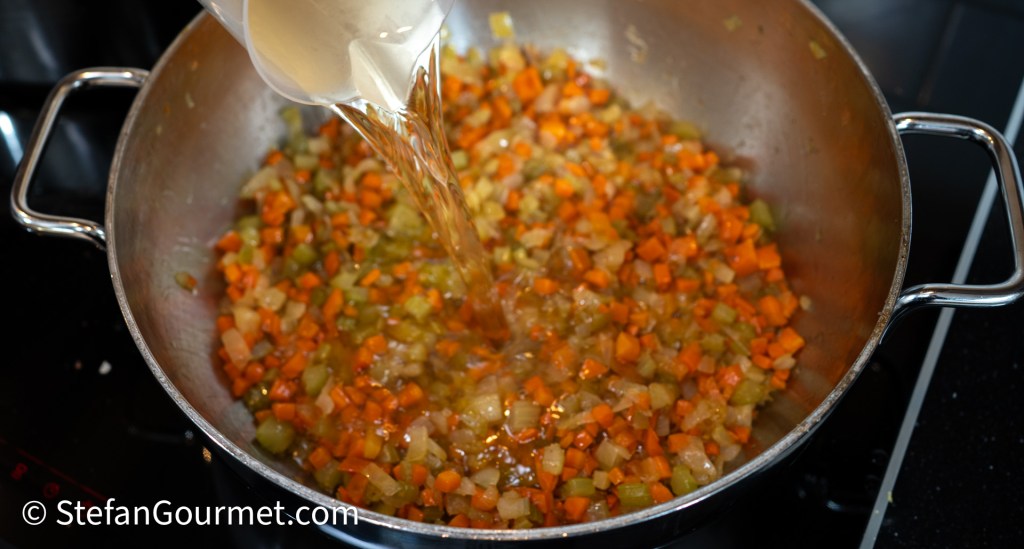
I deglazes the aromatics and the meat separately, each with half of the wine.
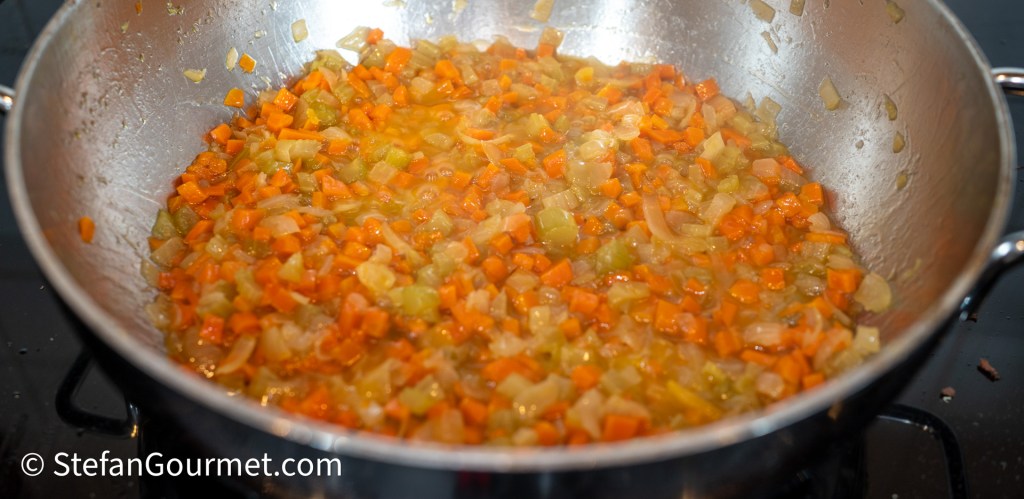
When the wine in the casserole with the aromatics had reduced sufficiently…
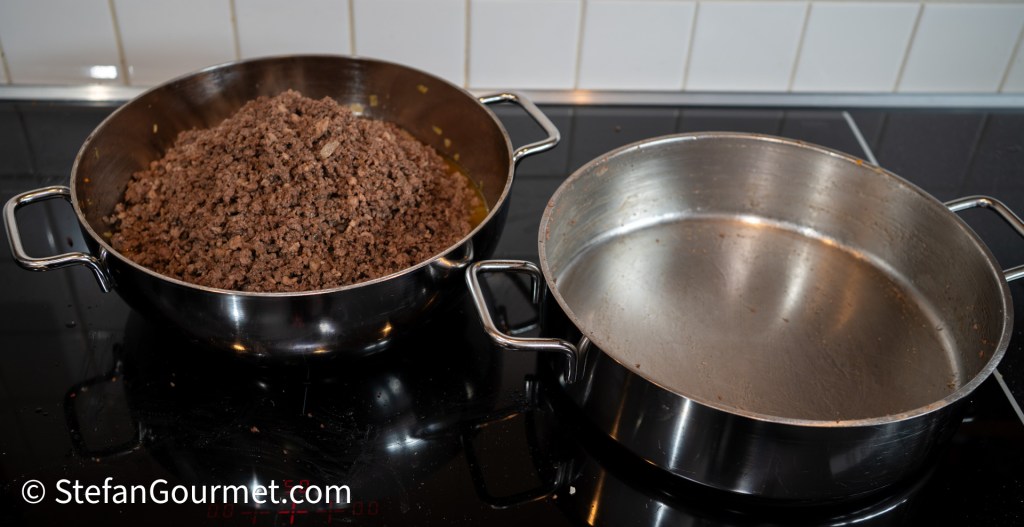
…I added the meat to the casserole. As you can see there is nothing left behind in the pan in which I sautéed the meat, because I scraped along the bottom with a wooden spatula after deglazing with the wine. This is important to get all of the flavor into your ragù.
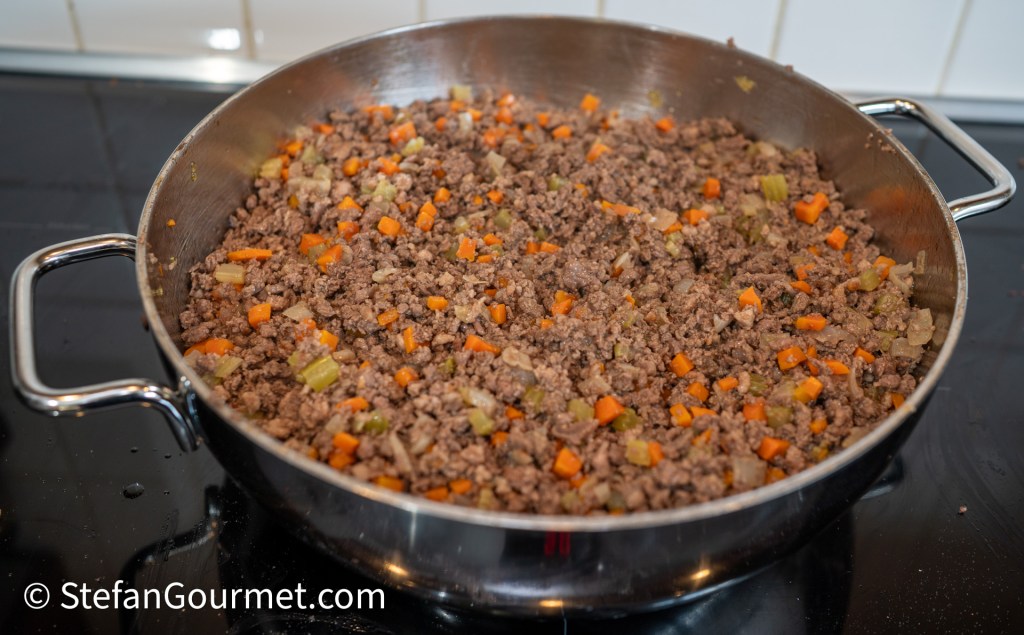
And then I mixed everything together.
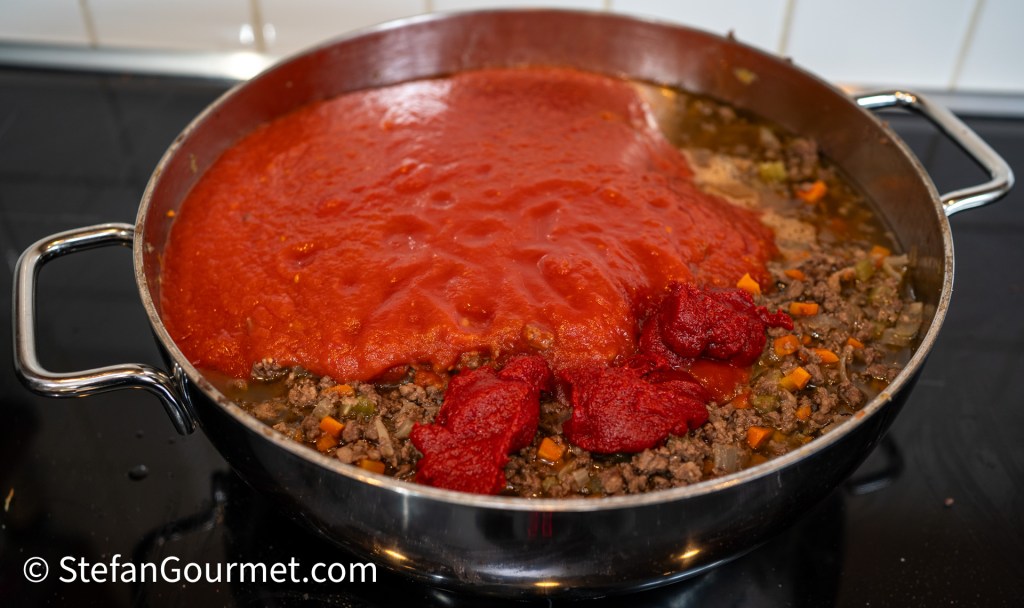
Adding the tomato:
- 1982: add the sieved tomatoes or peeled tomatoes
- 2023: add the sieved tomatoes and the tomato paste
- Comments: no differences besides the different type of tomatoes.
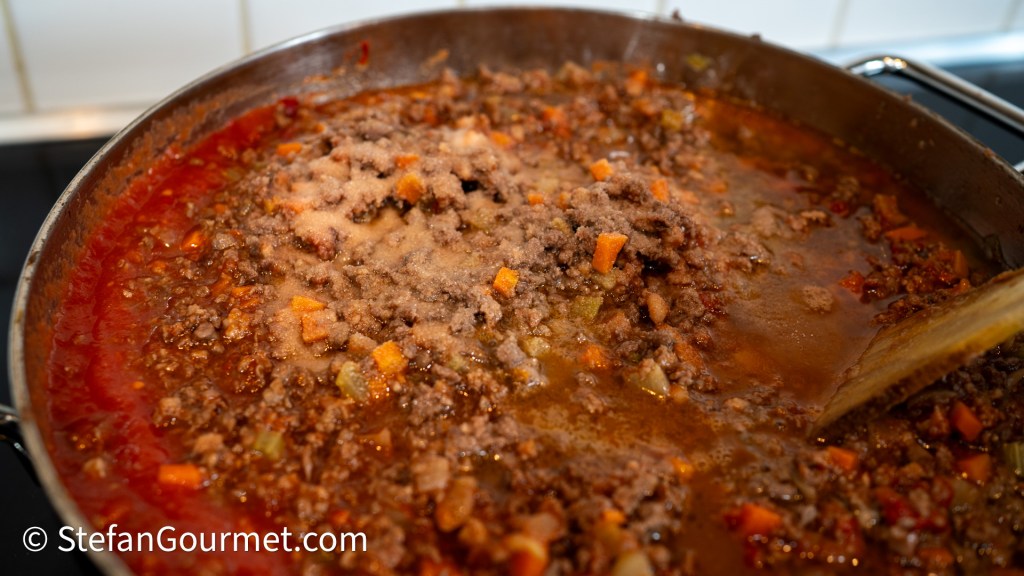
This is where I added some salt, as I was using fresh pork belly rather than pancetta, and I was not using a bouillon cube (which is usually at least 50% salt). Both recipes just mention to “adjust the seasoning” at the end, but to me that only makes sense if you used pancetta and bouillon cubes. The salt does influence the Maillard reactions that occur during the cooking process, so I wanted to add some salt at this stage rather than waiting for the end.
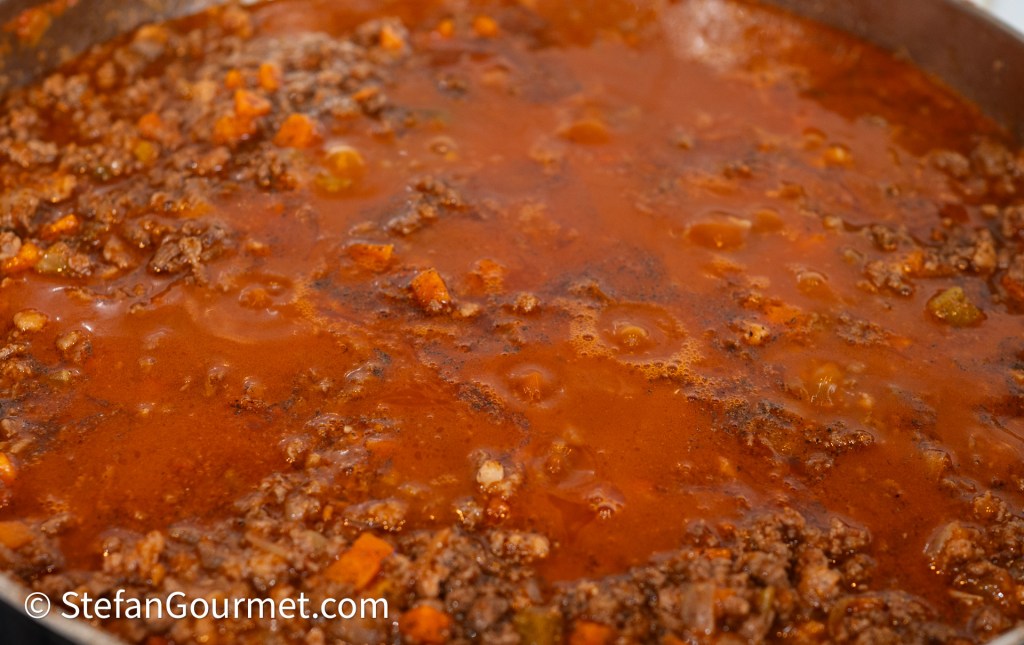
Simmering the ragù:
- 1982: cover, and allow to simmer for about 2 hours, adding stock as needed.
- 2023: keep stirring well, add a cup of boiling stock (but you could also just use water) and allow to cook gently, covered, for about 2 hours (or 3 hours if you prefer and depending on the types of meat you are using), adding hot stock little by little as needed.
- Comments: the new instructions are more elaborate, as of course you were supposed to stir in the 1982 recipe as well, even though it wasn’t mentioned specifically. A gentle simmer means that there are only a few bubbles.
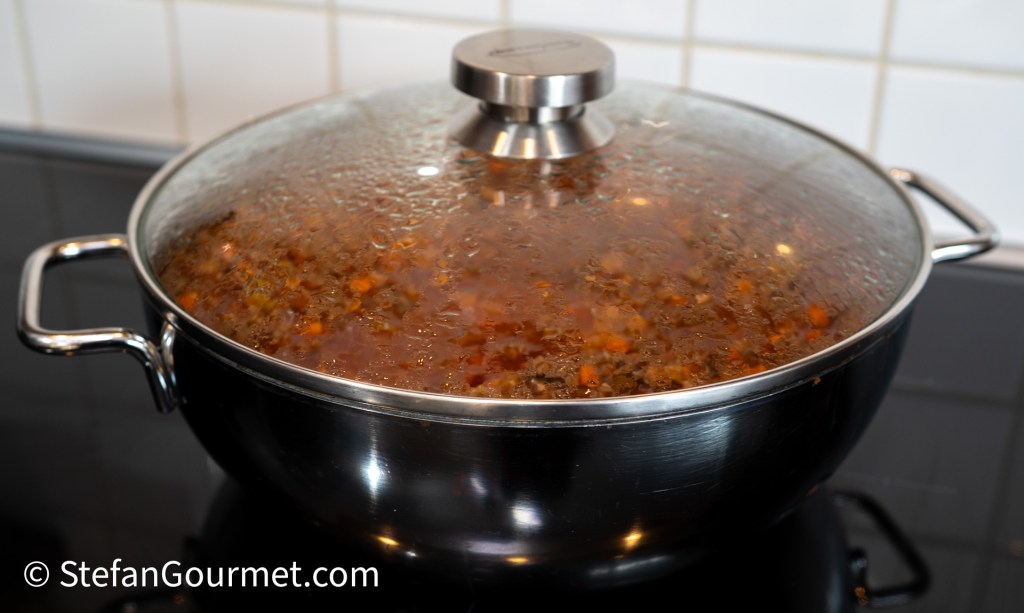
I thought the ragù was wet enough, and did not add any water or stock.

It is important to stir now and then, to prevent the ragù from sticking to the bottom.
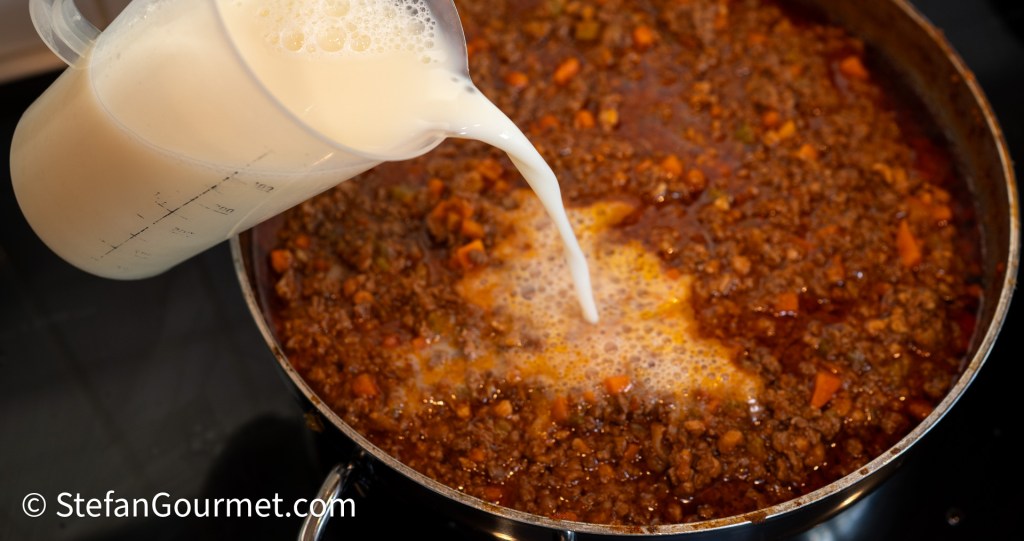
Adding milk:
- 1982: near the end add the milk to tone down the acidity of the tomatoes.
- 2023: halfway through the cooking, according to an advisable old tradition, you could add the milk, which needs to be reduced completely.
- Comments: the milk has become optional in 2023, but it is advised to use it (and I agree, because the milk is one of the most important factors that makes this ragù “bolognese” rather than a meat and tomato ragù from anywhere else in Italy).
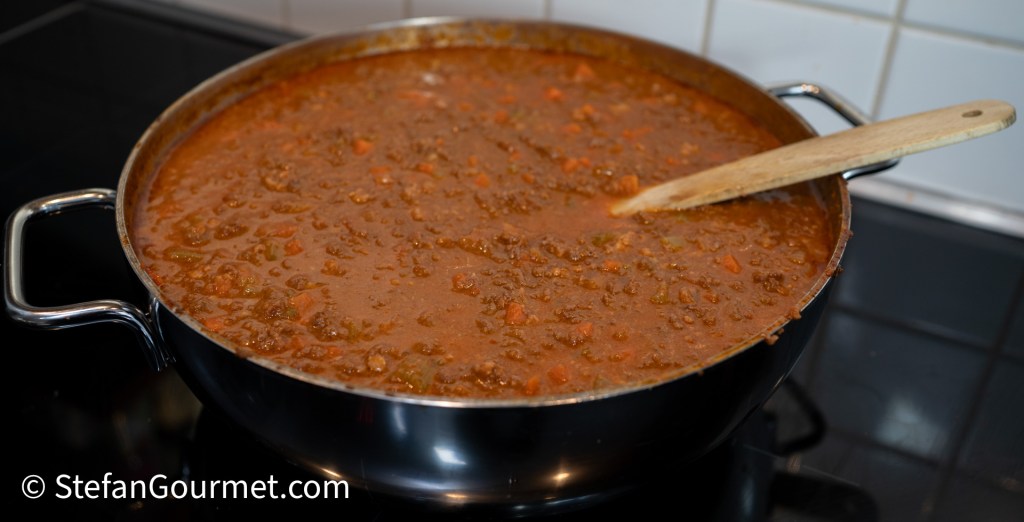
Stir until the milk has been mixed in well.

I added the milk after 2 hours of simmering, and allowed the ragù to simmer uncovered after adding the milk, to allow it to reduce completely as instructed.

Finishing:
- 1982: adjust the salt and pepper. At the end, when the ragù is finished, according to the bolognese tradition, one adds cream if you are cooking to use the ragù to dress dried pasta. For (fresh) tagliatelle, you should not use cream.
- 2023: finally, at the end of the cooking, adjust the salt and pepper. The ragù should be a nice dark orange color, enveloping, and creamy.
- Comments: the tradition of adding cream at the end when the ragù is used for dried pasta has been removed in the new recipe. Probably because modern cooking is ‘lighter’.
I think it is interesting that neither recipe says anything about what type of pasta to use the ragù for (except for the reference to tagliatelle in the 1982 recipe). The standard in Bologna is fresh tagliatelle, but it could also be used to dress tortellini, or to make Risotto alla Bolognese.
Allowed Variations
Other than the variations already mentioned in the ingredients, the recipe lists the following allowed variations and enrichments:
- A dash of nutmeg (although not specified, I would insist on using freshly grated nutmeg);
- Chicken livers, hearts, or gizzards (although it is not specified, these should be minced and added at the same time as the beef);
- Pork sausage, skin removed and crumbled (also added at the same time as the beef);
- Blanched garden peas, added at the end of the cooking;
- Dried porcini mushrooms, soaked (although it is not specified, I would add these towards the end of the cooking and I would also add the filtered soaking water).
Nothing is specified about allowed variations in the proportions of the recipe.
Forbidden Variations
The following variations are not allowed:
- Veal instead of beef;
- Smoked pancetta;
- Using pork only;
- Garlic, rosemary, parsley, or any other herbs or spices;
- Brandy (instead of the wine);
- Flour (for thickening).
If you do make a ragù with these ingredients, it could still be delicious and it could even still be Italian, but it would not be alla bolognese.


Thanks a million, Stefan ! For passing on the ‘real and true’ current facts as detailed by the Bolognese City Fathers and writing out the two slightly varying sets of ‘rules’ from only forty years ago and now. And – anyone reading this may just realize that there is no ITALIAN food called ‘Spaghetti Bolognese’ or ‘spag bol’ as the dish is usually called Down Under! In this I have always respected Italian cuisine and used tagliatelle or rice. Personally, I have, on occasion, used chicken livers and nutmeg . . . and, perchance the unallowed cognac once or twice. Shall certainly repost your work as soon as possible – am having technical probs here . . .
LikeLiked by 2 people
Stefan, thanks for another excellent article. As a dutchman I always have difficulties with the English names of the various cuts of meats. Do you now of a place on the internet witch wil guide me with this translations? Or can you give me some hints on this yourself?
LikeLiked by 1 person
Hi Sjaak, meat is cut differently everywhere, which makes it difficult to translate names of cuts. Riblappen or sukade are the most easily available here from the cuts mentioned in the official recipe.
LikeLike
Interesting article and well researched. Thanks for sharing.
LikeLiked by 1 person
Fascinating! It’s funny to me that the Italians came up with a new authentic recipe. Personally, it doesn’t matter, especially when there are hundreds of authentic recipes among households, villages, regions, etc. But one shouldn’t be sent to jail or persecuted for using veal in a bolognese! It’s all very amusing.
LikeLiked by 1 person
You are right dear Mimi, it can sound very amusing to non-Italians. Have you heard of the term ‘pasta wars’ for instance? What grates some Italians is how what non-Italians will want to make up a dish and give it the Italian name and it won’t taste anything like the Italian version of that dish – very often the food in question tastes like downright shit (I have eaten some so-called Italian food in London and let me tell you I was not impressed – although now, I am told, things are different, phew). It gives Italian food a bad name … well, at least, that is part of the reason. As for the new authentic recipe – I find that interesting too. But I suppose it’s part of the UNESCO non-tangible heritage business.
LikeLiked by 3 people
Am delighted you have written and, altho’ not Italian, agree with and echo every word you have put down. Am certain Stefan will also totally agree!
LikeLiked by 1 person
Come sempre, caro Stefan, sei stato bravo, molto bravo!
LikeLiked by 2 people
Perfetto! In particolare le cose vietate
LikeLiked by 1 person